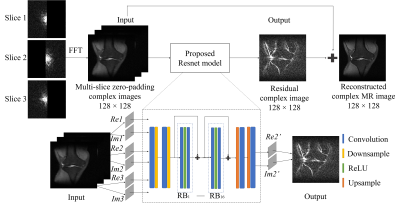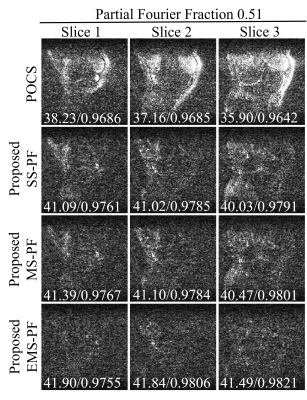Linshan Xie1,2, Yilong Liu1,2, Linfang Xiao1,2, Peibei Cao1,2, Alex T. L. Leong1,2, and Ed X. Wu1,2
1Laboratory of Biomedical Imaging and Signal Processing, The University of Hong Kong, Hong Kong, China, 2Department of Electrical and Electronic Engineering, The University of Hong Kong, Hong Kong, China
1Laboratory of Biomedical Imaging and Signal Processing, The University of Hong Kong, Hong Kong, China, 2Department of Electrical and Electronic Engineering, The University of Hong Kong, Hong Kong, China
A residual network based reconstruction method is
proposed for multi-slice partial Fourier acquisition, where adjacent slices are
sampled in a complementary way. It enables highly partial Fourier imaging
without losing image details or significant noise amplification.

Figure 1 The flowchart of the
proposed EMS-PF reconstruction method, with adjacent slices having complementary
sampling patterns. Re and Im denote the real and imaginary parts
of the reconstructed slice (Slice 2) and its adjacent slices (Slices 1 and 3); Re2’ and Im2’ denote the real and imaginary parts of the predicted residual
image. The ResNet model has 16 RBs and each of them contains 2 convolutional
layers followed by Rectified Linear Unit (ReLU) activation function. In each
convolutional layer, 64 convolutional kernels of size 3×3 each are included.

Figure 3 Error maps of the
reconstructed images in Figure 2 with enhanced brightness (×10) and
corresponding peak signal-to-noise ratio (PSNR) / structural
similarity (SSIM) at PF fraction=0.51. It was obvious that the proposed EMS-PF
outperformed the other methods in terms of reduced residual error.